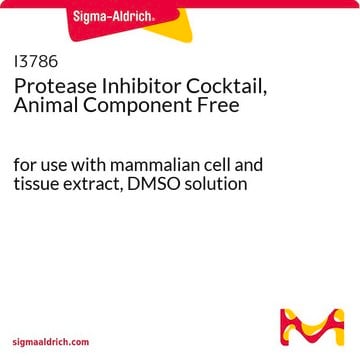539131
Protease Inhibitor Cocktail I
lyophilized, for the inhibition of aspartic, cysteine, serine, metalloproteases and aminopeptidases
Synonym(s):
Protease Inhibitor Mix, Protease inhibitor
About This Item
Recommended Products
product name
Protease Inhibitor Cocktail Set I, A cocktail of five protease inhibitors that will inhibit a broad range of proteases and esterases. Supplied with a data sheet.
form
lyophilized
manufacturer/tradename
Calbiochem®
storage condition
OK to freeze
desiccated (hygroscopic)
shipped in
wet ice
storage temp.
−20°C
Related Categories
General description
Specificity
Application
- cold radioimmunoprecipitation assay (RIPA) buffer to prepare cell lysates for western blotting
- RIPA lysis buffer to extract total protein from rat liver tissues and AML12 cells
- sucrose solution to homogenize mice cortices for myelin isolation
Biochem/physiol Actions
Features and Benefits
- Protease Inhibitor Cocktails offer protection of target protein against degradation in crude extracts
- Ready for reconstitution
Warning
Reconstitution
Other Notes
Legal Information
Signal Word
Danger
Hazard Statements
Precautionary Statements
Hazard Classifications
Acute Tox. 4 Inhalation - Eye Dam. 1 - Skin Corr. 1A - STOT RE 2 Inhalation
Target Organs
Respiratory Tract
Storage Class Code
8B - Non-combustible corrosive hazardous materials
WGK
WGK 3
Flash Point(F)
Not applicable
Flash Point(C)
Not applicable
Certificates of Analysis (COA)
Search for Certificates of Analysis (COA) by entering the products Lot/Batch Number. Lot and Batch Numbers can be found on a product’s label following the words ‘Lot’ or ‘Batch’.
Already Own This Product?
Find documentation for the products that you have recently purchased in the Document Library.
Customers Also Viewed
Our team of scientists has experience in all areas of research including Life Science, Material Science, Chemical Synthesis, Chromatography, Analytical and many others.
Contact Technical Service


















